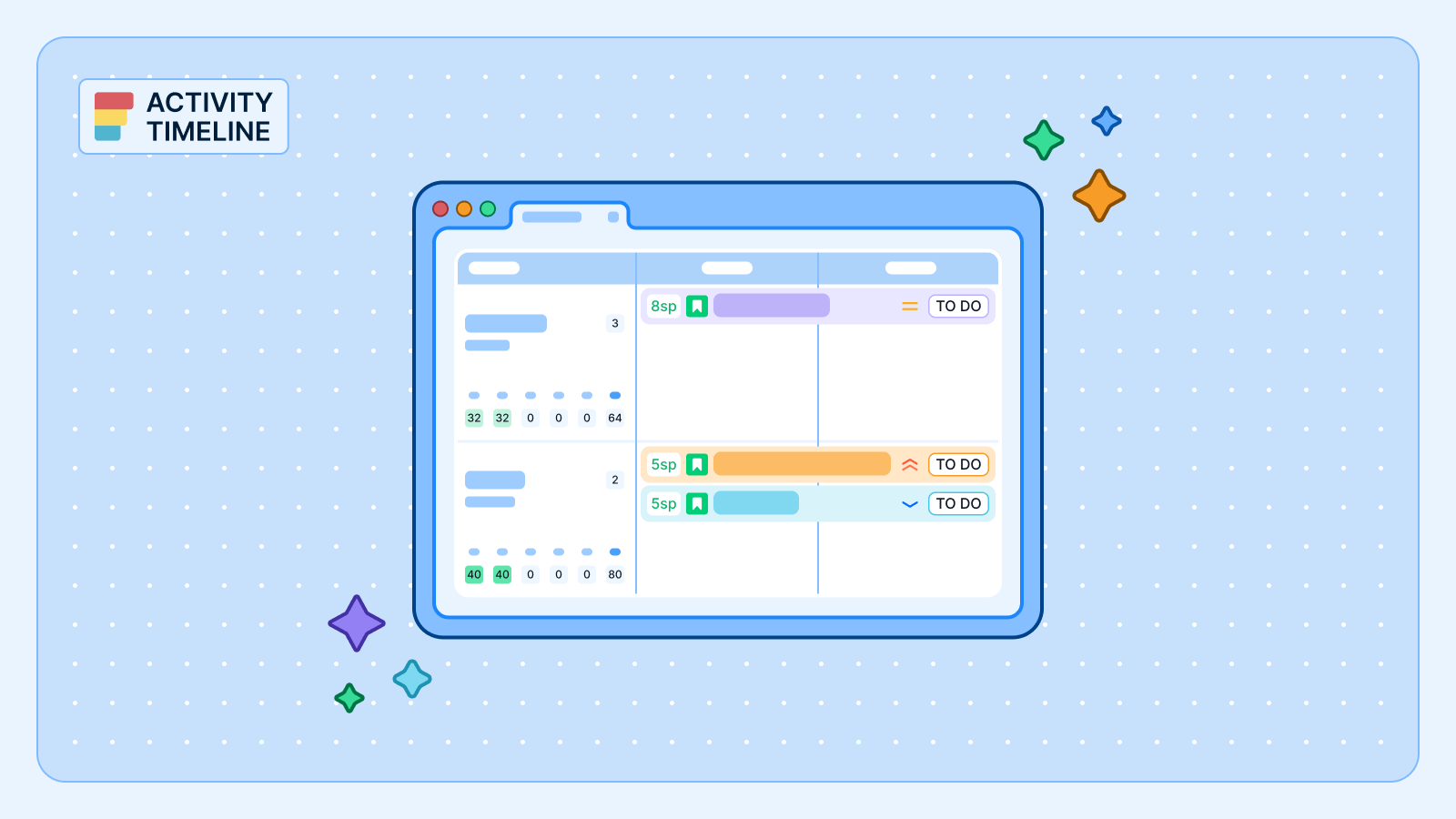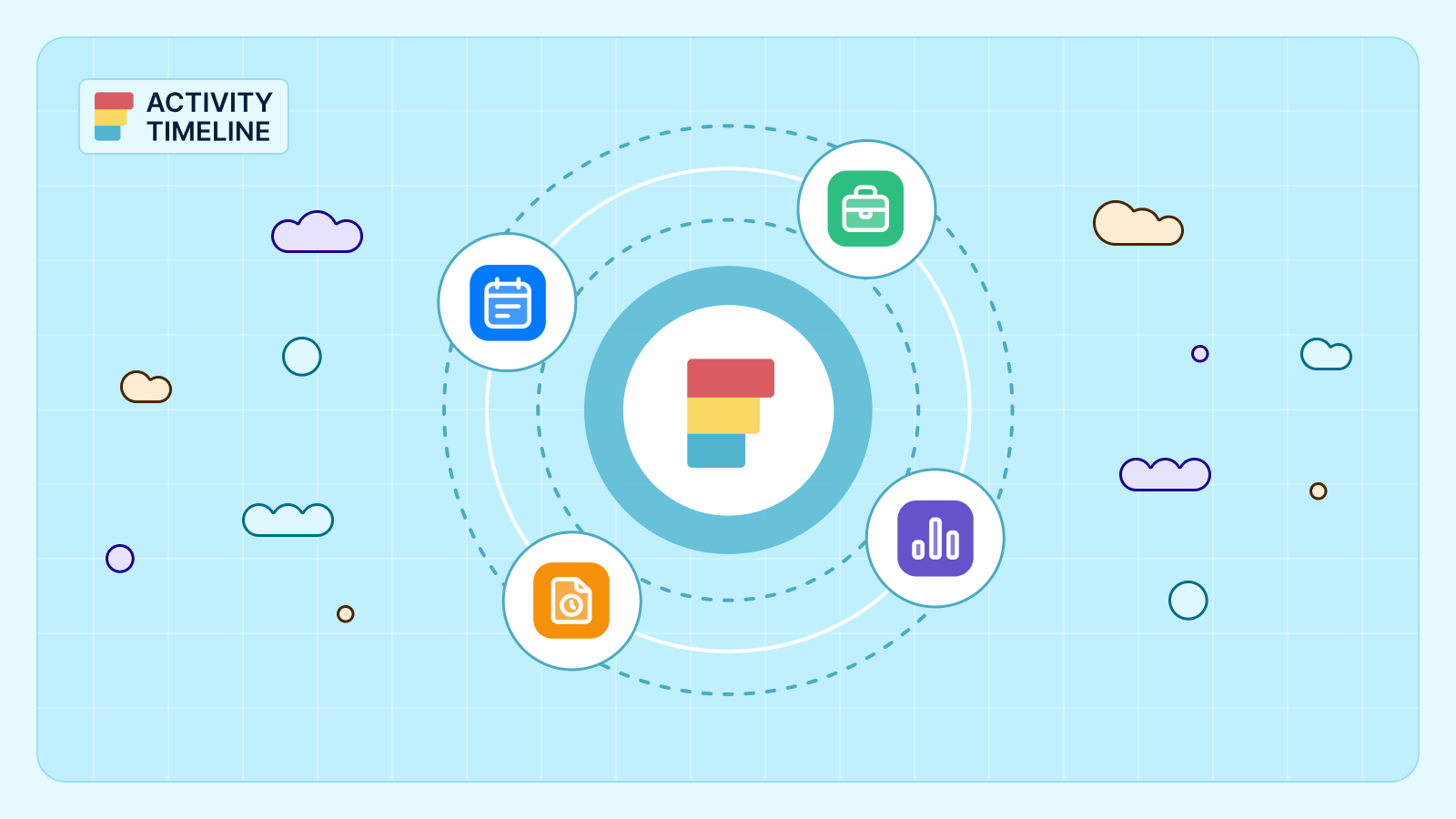A arte do planejamento de recursos se tornou a diferença entre organizações prósperas e aquelas que lutam para acompanhar o ritmo. Compreender a diferença fundamental entre carga de trabalho e capacidade está no cerne da gerenciamento efetivo da capacidade. Esses dois conceitos costumam ser confundidos, mas servem a propósitos distintamente diferentes no planejamento organizacional.
Neste artigo, descrevemos como encontrar seu ponto ideal usando ambos e como o ActivityTimeline pode ajudar com isso.
TL; DR
O ActivityTimeline aborda o problema de 62 bilhões de dólares de esgotamento no local de trabalho, fornecendo visibilidade em tempo real da carga de trabalho da equipe versus a capacidade. A plataforma usa indicadores codificados por cores para mostrar instantaneamente quem está sobrecarregado (vermelho) versus subutilizado (verde), enquanto a funcionalidade de arrastar e soltar permite a redistribuição imediata das tarefas. Com integração nativa do Jira e suporte para horários tradicionais e histórias ágeis, ele atende equipes distribuídas em todos os setores. Como resultado, os gerentes evitam gargalos antes que eles aconteçam, os funcionários ganham autonomia sobre seus horários e as organizações otimizam a alocação de recursos sem esgotar talentos.
A distinção crítica: carga de trabalho versus capacidade
Carga de trabalho representa a quantidade estimada de trabalho atribuída a um recurso por um período especificado. Pense nisso como as tarefas, projetos e responsabilidades reais acumuladas no prato de um indivíduo. É o componente “o que precisa ser feito” da equação.
Capacidade, conhecida como “Capacidade disponível” no ActivityTimeline, serve como a medida com a qual a carga de trabalho é comparada. Representa o tempo e a energia disponíveis que uma pessoa pode dedicar de forma realista ao trabalho dentro de um determinado período de tempo. Não se trata apenas de horas de trabalho padrão — a capacidade pode ser configurada nos níveis organizacional e individual, levando em conta os padrões de produtividade pessoal, os níveis de habilidade e as flutuações diárias de disponibilidade.
Quando essas duas métricas se alinham adequadamente, as organizações descobrem seu ponto ideal de gerenciamento de recursos: aquela zona ideal em que os membros da equipe se sentem desafiados, mas não sobrecarregados, produtivos, mas não esgotados.
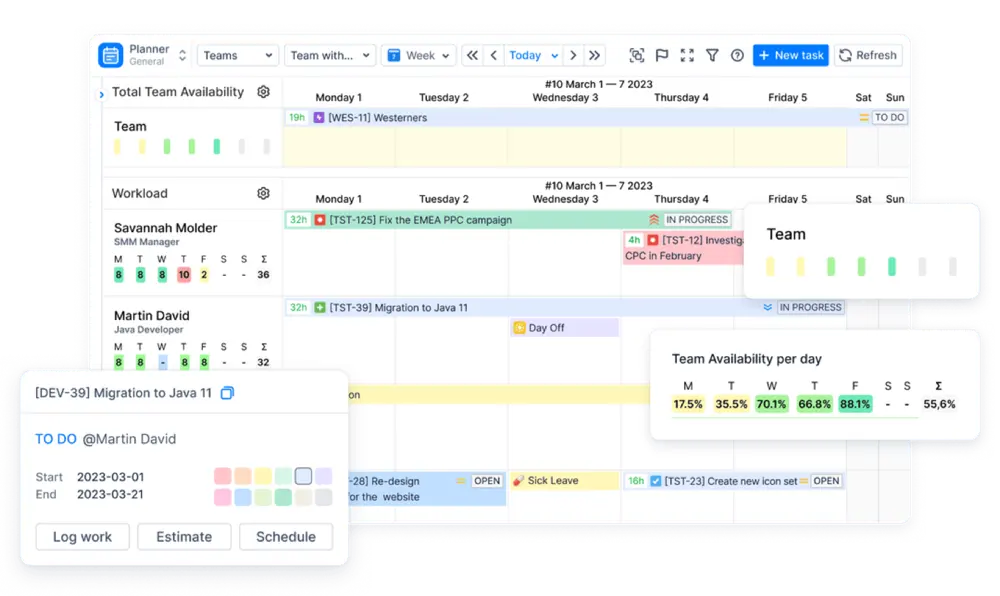
Cronograma de atividades funciona como um painel abrangente para indivíduos e equipes, criando uma compreensão em tempo real da alocação de recursos em todos os projetos. Os desenvolvedores da plataforma usam uma metáfora de orquestra convincente: cada funcionário vê sua partitura individual (tarefas) e entende como ela contribui para a sinfonia geral (cronograma do projeto), enquanto os gerentes mantêm uma visão panorâmica do maestro para garantir um desempenho harmonioso sem sobrecarregar ou subutilizar nenhum artista.
Inteligência visual: o sistema indicador de carga de trabalho
O principal recurso do ActivityTimeline é seu código de cores Indicador de carga de trabalho, que transforma dados complexos de alocação de recursos em sinais visuais instantaneamente digeríveis. Esse sistema aparece sob o nome de cada recurso, exibindo as horas alocadas com base nas tarefas agendadas e nos eventos personalizados.
O indicador emprega uma abordagem sofisticada da psicologia das cores:
- Verde sinaliza o estado ideal — carga de trabalho nominal em que a produtividade prospera sem risco de esgotamento
- Oliva sugere subutilização, indicando oportunidades para maximizar o potencial de recursos
- Amarelo alerta sobre subcarga, destacando a capacidade que poderia ser melhor aproveitada
- Vermelho claro informa que uma pessoa está um pouco sobrecarregada e alguns ingressos precisam ser reagendados para outro dia
- Vermelho gera alertas imediatos de superalocação, quando as tarefas atribuídas excedem a capacidade real (como programar 16 horas de trabalho em um dia de 8 horas).
Alguns códigos de cores mais específicos que a ferramenta inclui são os seguintes:
- Azul—Fora do escritório; um dia de folga, férias, licença médica ou feriado estão programados para um usuário
- Roxa—Dia de folga, férias, licença médica ou feriado são atribuídos no horário registrado ou no fim de semana
- Cinza—a carga de trabalho é “0" h/dia; nenhuma carga de trabalho é exibida nesse dia.
É possível personalizar o intervalo de dados para indicadores de carga de trabalho acessando o 'Personalização da faixa de cores do indicador de carga de trabalhoopção 'sob a Configurações -> Indicador de carga de trabalho configurações.

Esse sistema visual opera em quatro modos distintos: carga de trabalho, disponibilidade, número de problemas e registros de trabalho e carga de trabalho, fornecendo aos gerentes várias lentes para avaliar a alocação de recursos.
Além das horas: a revolução de Story Points
Equipes de desenvolvimento modernas geralmente trabalhar em pontos de história em vez de estimativas de tempo tradicionais. Um obstáculo comum que muitas equipes enfrentam é a discrepância nas definições de “pontos de história” em diferentes equipes. Para uma equipe, uma pessoa pode completar confortavelmente 5 pontos da história em um sprint, enquanto para outra, espera-se que essa mesma pessoa entregue 20. Isso cria um desafio significativo quando os indivíduos contribuem para várias equipes, pois sua carga de trabalho se torna difícil de medir e equilibrar de forma consistente.
Para estabelecer um terreno comum e garantir uma distribuição justa da carga de trabalho, as horas geralmente surgem como a opção mais confiável. Eles fornecem uma linha de base clara e inegável para alinhar o esforço esperado de um indivíduo, independentemente da equipe para a qual ele está contribuindo ou de como essa equipe define seus pontos de história. Em seguida, o ActivityTimeline preenche a lacuna por meio de mecanismos inteligentes de conversão. Agora você pode configurar os fatores de conversão globalmente em todos os projetos ou individualmente para iniciativas específicas, com as configurações específicas do projeto tendo precedência.
Capacitação dos funcionários: carga de trabalho autogerenciada
Talvez o recurso mais inovador do ActivityTimeline seja seu Módulo de espaço de trabalho, que transforma funcionários de destinatários passivos de tarefas em gerentes ativos de sua própria produtividade. Essa abordagem centrada no funcionário reconhece que as pessoas mais próximas do trabalho geralmente têm os melhores insights sobre agendamento realista e gerenciamento de capacidade.

Por meio de seus Cronograma pessoal, os funcionários obtêm um controle sem precedentes sobre sua vida profissional. Eles podem revisar atribuições e prazos, atualizar status e estimativas de tarefas, agendar folgas e registrar trabalhos em várias interfaces, desde simples cliques em gráficos até sofisticadas funcionalidades de cronômetro.

A plataforma é Módulo de trilha oferece várias perspectivas de visualização (progresso, cronograma, detalhado) com vários modelos, ajudando as pessoas a monitorar as horas necessárias versus as registradas e as taxas de conclusão do quadro de horários.

Excelência em integração: Jira e muito mais
A integração perfeita com o Jira do ActivityTimeline demonstra a compreensão das realidades modernas do fluxo de trabalho. Todas as tarefas do Jira de projetos habilitados preenchem automaticamente o Painel de problemas, onde os usuários podem arrastar e soltar tarefas diretamente em seus cronogramas.
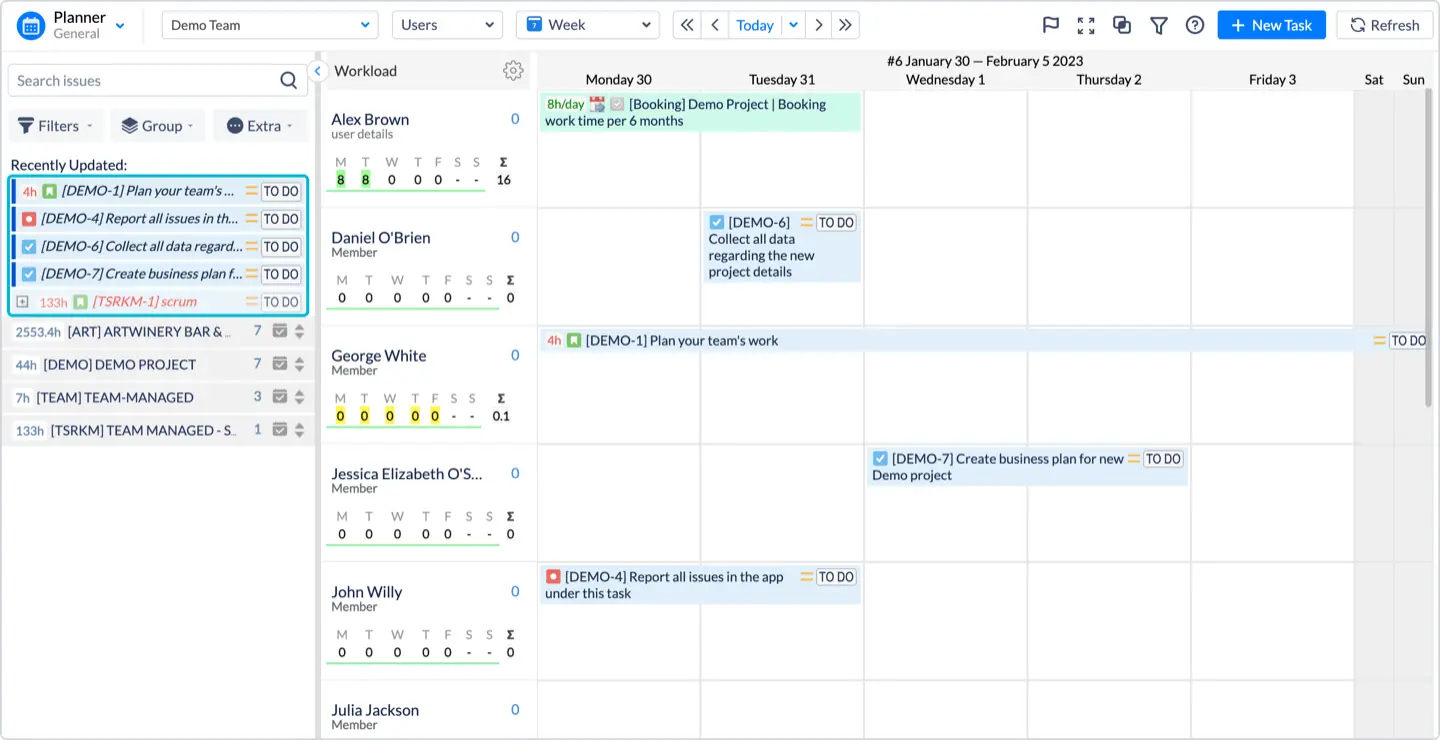
Use-o para classificar ou agrupar problemas por pessoa, projeto, prioridade, status, lançamento, sprint, componente, tarefa principal ou tipo de problema. Além disso, os filtros rápidos oferecem a possibilidade de selecionar vários itens em uma lista suspensa. Se nenhum item específico for escolhido no filtro suspenso de seleção múltipla, todos os problemas pertencentes a esse filtro serão exibidos.

Quando As datas de início/término são mapeadas, essas ações atualizam automaticamente os campos correspondentes do Jira, mantendo a consistência dos dados em todas as plataformas.
A plataforma vai além do rastreamento padrão de problemas por meio de um gerenciamento abrangente de eventos personalizados:
- Reserva aloca capacidade para atividades específicas sem exigir tarefas do Jira
- Categorias de folga (feriados, licença médica, férias) excluem dias dos horários de trabalho com fluxos de trabalho de aprovação opcionais
- Notas forneça lembretes simples sem afetar os cálculos de capacidade
- Horas extras adiciona capacidade temporária para o trabalho extra planejado
- Espaços reservados habilite o planejamento de cenários sem alterar os problemas reais do Jira
Planejamento centrado no sprint
Para equipes ágeis, Integração de sprint da ActivityTimeline exibe automaticamente as tarefas nos cronogramas do usuário com base nas datas do Jira Sprint.
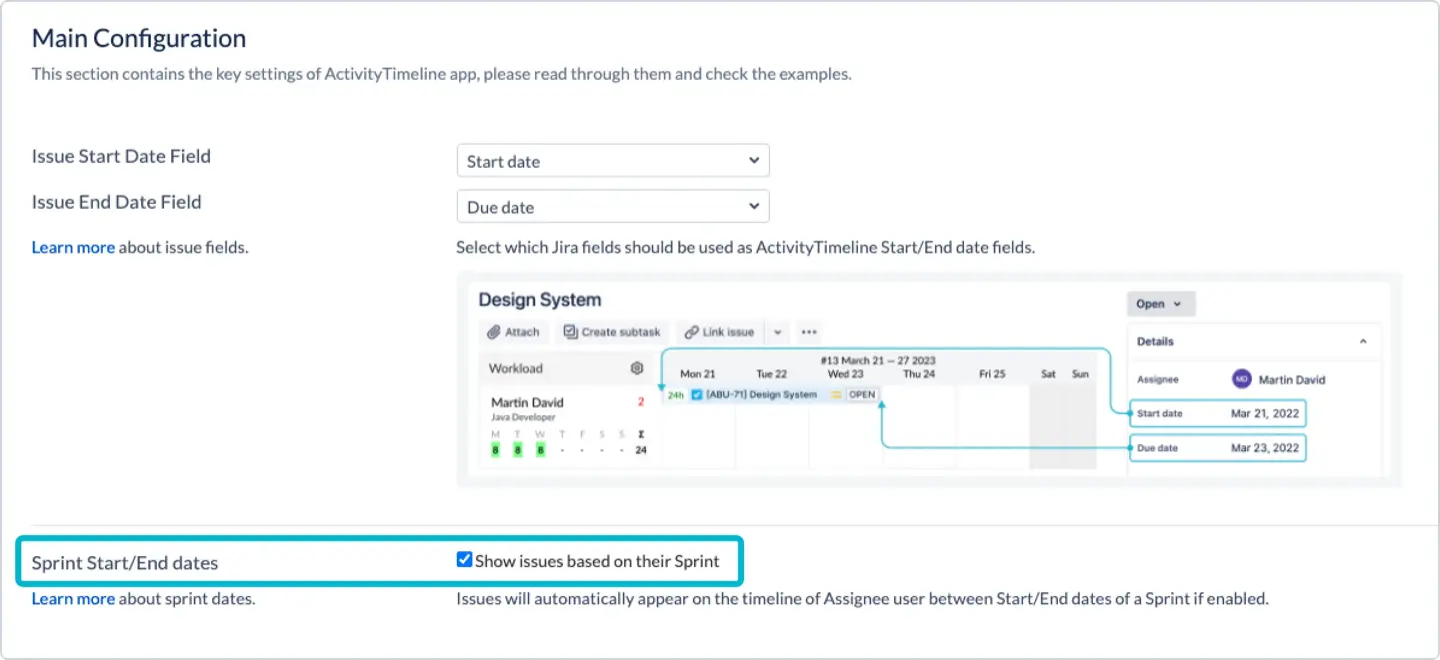
Os sprints são visualizados no Painel Milestones, e as tarefas podem ser atribuídas aos sprints por meio da funcionalidade simples de arrastar e soltar. A plataforma lida de forma inteligente com conflitos de prioridade de data, adotando como padrão as datas diretas de início/término da emissão e oferecendo configurações avançadas para priorizar as datas do sprint quando necessário. Desde que seus sprints no Jira tenham datas de início e término e os problemas sejam atribuídos aos usuários, o sistema refletirá essas tarefas nos cronogramas automaticamente.
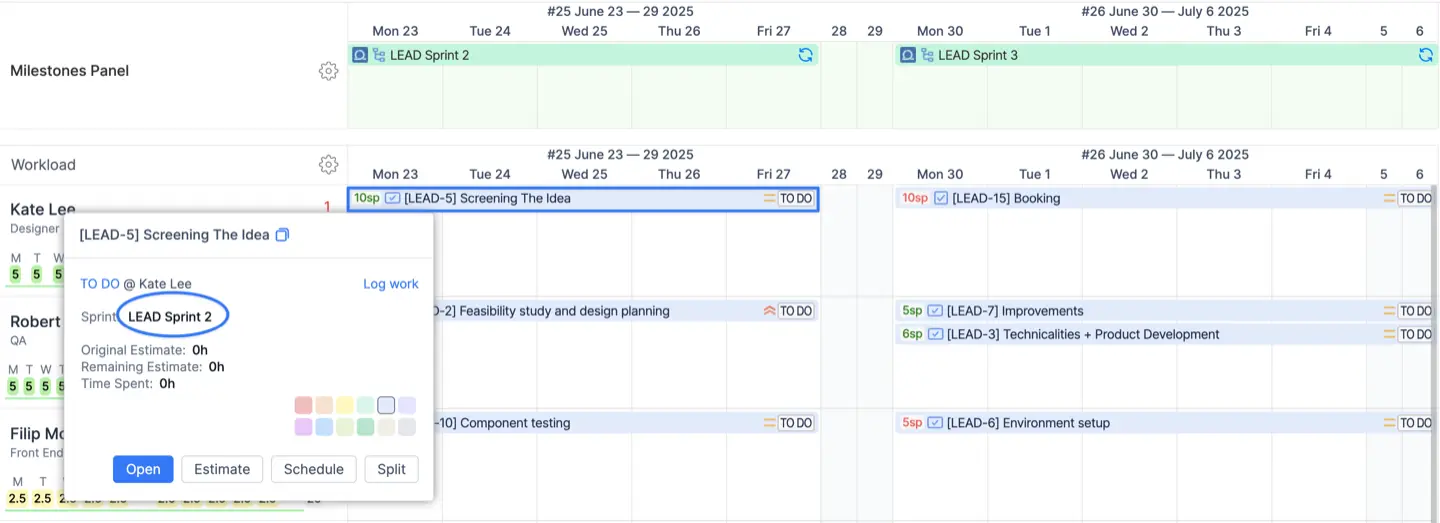
Aplicações do mundo real em que o cronograma de atividades brilha
A versatilidade da plataforma se torna aparente ao examinar cenários concretos de implementação em diferentes contextos organizacionais.
A crise de lançamento de produtos
Considere uma empresa de software correndo em direção a um prazo crítico para o lançamento de um produto. O gerente de projeto descobre que seu desenvolvedor principal mostra alertas vermelhos: 16 horas de trabalho estimadas programadas para a próxima terça-feira contra uma capacidade de 8 horas. Simultaneamente, a equipe de controle de qualidade mostra indicadores amarelos, sinalizando subutilização. Com a interface de arrastar e soltar do ActivityTimeline, as tarefas podem ser redistribuídas em tempo real, transferindo as responsabilidades de revisão de código para os engenheiros de controle de qualidade disponíveis.
O Agency Account Shuffle
As agências de marketing enfrentam mudanças constantes na prioridade dos clientes. Além disso, eles geralmente lutam com alocação de recursos em todas as demandas concorrentes dos clientes. Quando um grande cliente acelera repentinamente o cronograma da campanha, o recurso de eventos personalizados do ActivityTimeline permite que os gerentes de contas criem rapidamente entradas de “horas extras” para os membros da equipe afetados, aumentando temporariamente sua capacidade e bloqueando simultaneamente os eventos de “folga” na semana seguinte para evitar a exaustão.
O desafio da consultoria sazonal
As empresas de serviços profissionais experimentam flutuações sazonais previsíveis. Durante a temporada fiscal, uma empresa de consultoria usa a configuração de capacidade individual da ActivityTimeline para acomodar diferentes padrões de trabalho — os consultores seniores podem aumentar a capacidade diária de 8 para 10 horas, enquanto a equipe júnior mantém os horários padrão. O recurso de conversão de pontos históricos da plataforma se mostra inestimável aqui, traduzindo estimativas de engajamento do cliente em alocações horárias realistas em vários níveis de habilidade.
O dilema da coordenação da equipe remota
Com equipes distribuídas em todos os fusos horários, o cronograma pessoal do ActivityTimeline se torna crucial para o gerenciamento autônomo do trabalho. Um desenvolvedor na Europa Oriental pode revisar seu módulo Workspace todas as manhãs, identificando conflitos de prazos e ajustando proativamente as prioridades das tarefas antes que o gerente de projetos baseado nos EUA comece o dia. A plataforma é métodos de registro de várias vezes— da funcionalidade do cronômetro aos ajustes do registro de trabalho de arrastar e soltar — acomoda diferentes estilos de trabalho e preferências culturais.
O desafio da transferência de conhecimento
Quando membros experientes da equipe tiram uma licença planejada, a combinação da ActivityTimeline de Eventos “Day Off” e a reatribuição de tarefas se torna inestimável. Um líder técnico que agende duas semanas de férias pode identificar suas responsabilidades críticas por meio da visualização do cronograma e, em seguida, usar a interface de arrastar e soltar da plataforma para redistribuir as tarefas aos membros apropriados da equipe. Os indicadores visuais da carga de trabalho mostram imediatamente se a redistribuição cria problemas de capacidade, permitindo um ajuste proativo antes do início da ausência.
A linha de fundo
O verdadeiro poder do ActivityTimeline reside na criação de cenários ganha-ganha. As organizações se beneficiam da utilização otimizada de recursos, da redução dos atrasos nos projetos e da maior previsibilidade da entrega. Os funcionários ganham autonomia sobre seus horários, melhoram o equilíbrio entre trabalho e vida pessoal e reduzem o risco de esgotamento por meio de um gerenciamento realista da carga de trabalho.
À medida que os modelos de trabalho remoto e híbrido continuam remodelando as estruturas organizacionais, ferramentas como o ActivityTimeline se tornam uma infraestrutura essencial para manter a coerência e a produtividade da equipe. A questão não é se as organizações precisam de melhores ferramentas de planejamento de recursos, mas se elas podem se dar ao luxo de operar sem elas.


